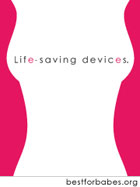Cloth or Disposable
Many first-time parents considering what kind of diapers to put their infant in must often wade through seemingly endless facts and figures on top of conflicting recommendations from acquaintances, doctors and health blogs. Other issues aside, the argument often breaks down to a question of convenience vs. economics.
Before disposable diapers were invented in the 1940s, cloth was the standard. However, the convenience of being able to simply wrap up the waste and toss it in the trash led to a surge in popularity for disposables, which have replaced their cloth predecessors as the preferred diaper in America. For many parents with busy lives, the idea of doing extra (and smelly) laundry is unappealing.
Nonetheless, environmental and health concerns have led to an increased usage of cloth diapers, which no longer require the use of safety pins. These reusable nappies have evolved since the 1940s, coming in all shapes and sizes, in various designs and materials.
Parents must evaluate the advantages and drawbacks of choosing disposable or cloth, and which best fits their lifestyle.
'Time saver'
Like many parents, Sally Malay used disposable diapers with each of her three sons, who are now ages 3, 4 and 6 - and potty trained. When she had her eldest son Luca, she was running a business from home. When her second son was 6 months old, she began working full-time, like her husband.
"Honestly, cloth diapers didn't even cross my mind," says Malay, whose mother used cloth for her as a baby. "I thought (disposables) would be convenient -- a time saver."
One type of disposable Malay found particularly convenient were overnight diapers, which -- while bigger and more expensive -- are intended to last a child through the night.
"Because I was working full-time, whenever my sons became old enough to sleep through the night, it meant so much not having them crying because their diaper was feeling saturated," Malay says. "It was a huge help for me to get that extra bit of sleep."
For Malay and her husband, the costliness of disposables was not a huge problem.
"While it wasn't really expensive, when we stopped using diapers, we definitely noticed a difference in terms of having extra cash," Malay says. "But we just considered it an expense of having a baby."
Jennifer Aguon, like Malay, chose disposables for her three children. While the eldest two are 4 and 2 years old, her youngest, Aurora, was born just three months ago. Aguon also selected disposable diapers for the immediate convenience.
"When I was potty training one, the other was still in diapers," Aguon says. "And it's not fun to wash loads of dirty underwear and dirty diapers."
While Aguon says she considered cloth, she ultimately chose disposables, partly because she had to work and often had to turn to daycares and sitters for childcare. She says she didn't want to burden any caretakers with having to do more dirty work than necessary when changing diapers.
"Whenever you leave your child with someone else, you want to make it as easy as possible for them," Aguon says.
Because Malay's children went to day care rather young -- her eldest was around 8 months old - she says disposables were the better choice. "I thought that disposables might be more sanitary and that cloth would make more work for the carer," Malay says.
'In the long run'
Amanda Wooley is one mom who used cloth diapers for her son, Toma, now almost 4 years old. Wooley says her older sister set an example by using cloth diapers on all four of her children.
"I thought there was no reason why I wouldn't use them," Wooley says. "For my sister, it was an environmental thing, but after I read more about the chemicals in disposable diapers, I thought to myself, 'How can I even consider putting him in this stuff?'"
Disposable diapers contain dyes, fragrances and two chemicals commonly cited by cloth diaper proponents as particularly dangerous: sodium polyacrylate and dioxin.
Sodium polyacrylate is a gel used inside the diaper for absorption; it has been linked to toxic shock syndrome, cancer and allergic reactions. While dioxin is not intentionally added to disposable diapers, it is a by-product of the paper bleaching process and is associated with damage to the central nervous system, kidneys and liver, according to the Environmental Protection Agency.
Wooley says the initial cost of getting started with cloth diapers is relatively high compared to disposable diapers, which can often turn parents off the idea from the beginning. While the diapers are reusable, each costs about $15 to $25. According to Wooley, an infant uses a minimum of 10 diapers a day, so parents thinking of using cloth will need to consider how often they will need to wash the diapers as well as how often they are able to wash.
The dirty cloth diapers need to be washed separately from regular laundry, Wooley says. Parents also need to be aware of what chemical products come into contact with the diapers and use perfume - and dye-free detergents. All of these are, of course, issues that parents using disposable diapers do not have to contend with. For Wooley, these inconveniences are worth the savings. "It is definitely much cheaper in the long run to go with cloth diapers," Wooley says.
Michelle Pier was drawn to the financial savings cloth diapers offered. Because she and her husband received disposable diapers as gifts for their first child, they started out using both and gradually transitioned to cloth.
"I was really broke at the time, so whenever I had extra money, I bought a few here and there and gradually worked my way up," Pier says.
While extra laundry may be daunting for many parents, for Pier it was simply part of the parenting deal.
"You'd be surprised how much laundry (babies) have, whether cloth diapers or not," Pier says. "At the time, another load of laundry didn't faze me."
While Pier says there was an initial learning curve to cloth diapering, she eventually found a system that worked for her -- she only had to do laundry once or twice a week. The more diapers parents have, Pier says, the fewer laundry days per week are required. She'd just quickly clean the used diaper before throwing it into the big wash.
Buying Locally
Using cloth does not have to be expensive, according to Amanda Young, founder of Gaia Eco-Solutions, one of companies that sell cloth diapers.
Young says parents can actually make their own out of old T-shirts, or even buy secondhand diapers. Young herself traded old items around the house for her first stash of cloth diapers through an online diaper trading forum. One example is Diaper Swappers.
While some parents, like Wooley, use special polyurethane laminate "wet bags" to store dirty diapers in on the go, Young says plastic bags can work just fine.
"I think parents who use disposable diapers would probably opt for cloth more if they knew how much easier it actually is," Young says.
She says there is a stigma surrounding cloth diapers for parents thinking about switching - that cloth diapering is an all-or-nothing practice. However, she says parents can slowly bring cloth into their routine and that small changes can have big financial impacts - 150 uses with one cloth diaper can save a family about $52.
The biggest factor for Young is the environmental consequences of using cloth. According to EPA numbers, disposables make up about 60 percent of a family's waste output and can take up to 500 years to decompose in a landfill, sometimes longer.
"The biggest thing for me is that my children's children's children won't have to deal with the mess I left them," Young said.
Weighing your options - Cloth Diapers
Pros
- Cheaper than disposable in the long run.
- Do not contain chemical irritatants present in disposables.
- Sustainable and environmentally friendly.
- Can be used for future children (only $400 for laundering costs).
Cons
- Initially expensive (about $15-$25 each for all-in-one diapers).
- Parents need to wash 10 or more diapers for each day.
- Parents may need to use special detergents.
- May be problematic for caretakers.
Weighing your options - Disposable Diapers
Pros
- More convenient for travel and busy lifestyles.
- Some studies show reduced risk of infection in group setting.
- Initial purchase is cheaper.
- Less work for caretakers.
Cons
- More expensive than cloth (up to $4,000 over three years).
- Not biodegradable and end up in landfills.
- Contain dioxin and sodium polyacrylate.
- May aggravate diaper rash.
July 2, 2011
Diaper dilemma: Cloth vs. DisposableBy Lenika Cruz
For Pacific Daily News
Diaper dilemma: Cloth vs. disposable Pacific Daily News guampdn.com
Saturday, July 2, 2011
Subscribe to:
Post Comments (Atom)





















No comments:
Post a Comment